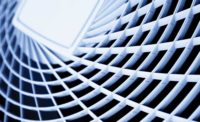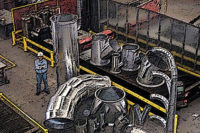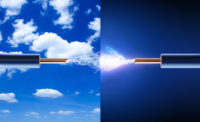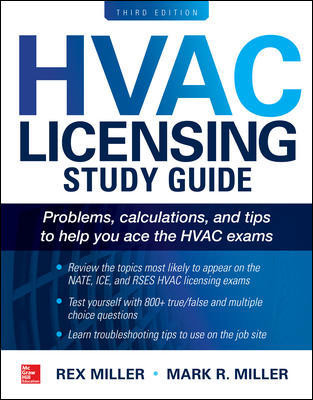However, actual installed fan operation and performance are often compromised by a lack of attention to detail to the fan installation, start-up, and O&M requirements. Remember, a task 95% complete is 100% incomplete, so let us look at some of the items often overlooked during fan installation, start up, and operation.
(Note – The information presented herein is intended to supplement, but not replace or supercede, the recommended guidelines and instructions provided by the original equipment (fan) supplier.)
FAN ISOLATION
Fans normally have three primary connection points and may also have several secondary connection points.
Primary connection points are the fan inlet, the fan outlet, and the fan base. Secondary connection points can include electrical or pneumatic items such as power, cabling, and instrumentation requirements.
Since the primary connection points are the main concerns we will simply state that for secondary connection points, either flexible conduits or “soft-mount” rigid connections are recommended. Soft mount means using some type of soft medium, such as a neoprene pad, to isolate the rigid member from a fan at its connection point.
So let us talk about fan isolation at the primary connection points.
FAN INLET AND OUTLET CONNECTIONS
When ducted, fan inlet and outlet connections should always be isolated from the duct system by using some type of flexible connector. While the type and integrity of the flexible connector will vary with the application requirements, flexible connectors are important for several reasons.
• They serve as a change in mass between the fan and the duct system to assist in breaking or isolating any transfer of vibration or resonance between the fan and the duct system.
• They serve to isolate the fan from structural loads or stress in the duct system. Remember, most fans are not intended to act as structural supports.
• They serve to compensate for small deviations in the alignment of a duct system to a fan.
• They serve to compensate for uneven materials growth (contraction or expansion) between the duct system and fan due to cold or hot temperatures.
• When noise is an issue, they can be designed with acoustical properties to assist in reducing fan noise emitting from the fan inlet or outlet.
If it is not possible, perhaps due to physical constraints, to use flexible connectors at the fan inlet and outlet connections, then try to ensure that the mass of the connecting duct system is noticeably different from the mass of the fan and its inlet and outlet connections
• After properly leveling, securing, and installing the fan in its working position, take care to make the final duct connections in sections small enough to take up any misalignments prior to the section immediately connecting to the fan. It is also recommended that the final duct section connecting to the fan should be supported with a “soft connection”, e.g., the use of a neoprene or suitable pad to isolate the support from energy transmission to or from its mount.
• In the case of applications having cold or hot temperatures, design the duct system so that it takes up any materials growth prior to reaching the fan. If the fan does not have a split housing, it is also a good idea to construct the final inlet duct section so that it is easily removable for wheel inspection and replacement.
FAN BASE CONNECTIONS
The best connection for the fan base is to properly secure (grout) the fan to a concrete foundation of suitable mass. Most fan manufacturers suggest a concrete foundation having a mass of three to six times the mass of the fan and motor assembly; however, you should always check with the fan supplier or design structural engineer for their recommendations for your specific application.
During this process — and before making any connections to the duct system — the fan should be properly leveled, then secured.
When the fan is properly leveled, grout and secure the fan to the concrete foundation.
When installing the fan onto a suitable concrete foundation when grouting is not possible, a good practice is to sandwich a flexible neoprene or other suitable flexible pad between the full contact surface of the fan base and the concrete foundation. This serves to both take up small differences in the flatness of the base vs. the concrete and to break up any energy transferred to or from the fan from the concrete foundation.
The next best connection for the fan base is to use a base isolation system, such as rubber in shear or spring or restrained spring, in conjunction with a structural or concrete block inertia base. Base isolation systems are normally used when the fan mounting structure does not have the above-noted minimum recommended mass to control energy being delivered by or to the fan.
A secondary reason to use a base isolation system is if the foundation on which the fan will be installed has shared machinery, which may actively transmit vibration through the foundation to the fan. Examples are mezzanines, building roofs, trailers, and support stands. Note: In all cases, the fan should be properly leveled, as much as possible.
Rubber in shear isolators with a structural base is normally suitable for fans having capacities of 40 hp or less. However, depending on the fan application and system pressures, rubber in shear isolators can be used for higher horsepower fans, normally up to 75 hp.
For some installations, environmental conditions should be considered when using rubber in shear isolators or neoprene pads. For instance, environmental conditions may reduce the performance of traditional neoprene materials due to chemical attack and degradation or temperature exposures, which can affect the aging, memory, or flexibility of the neoprene materials. In these cases, alternate materials such as EPDM or silicone may be considered.
For fan applications in the 40- to 75-hp range and above, spring or restrained spring isolators with a structural base are more common. Spring isolators are more common for non-seismic applications, while restrained spring isolators are typical for seismic requirements.
A variation of the spring isolation base is the concrete block inertia base, which is a site assembled channel or structural base frame designed to be filled with concrete to provide sufficient mass, then isolated using either spring or restrained spring isolators.
It should be noted that a common misconception is that by mounting a fan onto an isolation base — rubber in shear or spring — that the fan will run more smoothly and trouble free than when installed onto a concrete foundation. However, often this is not the case. AMCA 204 – Balance Quality and Vibration Levels for Fans allows a higher vibration threshold for isolation mount fans than for direct-foundation mounted fans. This is due to the lower efficiency of the rubber in shear and spring isolators to dissipate fan energy as compared to the higher efficiency of a suitable foundation to do the same.
DRIVE DATA
Drive data are helpful for parts replacement and future drive changes. From the fan drive package, record the v-belt type and size, belt quantity, drive centers (centerline distance from the motor shaft to the fan shaft), and drive tension rating. If the drive is direct coupled instead of v-belt, record the coupling manufacturer, size, and type/model in lieu of the v-belt data. If the fan is arrangement four, direct drive, record if the motor shaft-to-wheel connection is straight bore (and size) or a taper lock bushing type fitting (record model and size). Also note if there are any shaft turndowns; it is not uncommon for the fan shaft to have a turndown at either the wheel, bearings, or couple drive end.
At startup, verify and ensure that the following are within the design criteria: v-belt drive tension (using a commercially available tensioning tool) and drive alignment.
FAN BEARING AND VIBRATION DATA
Often overlooked, but always helpful, are fan bearing and vibration data at start up. These data are often valuable in establishing a newly installed condition that can be used for trending for future maintenance or failure analysis.
Record the bearing manufacturer, type and size, and bearing lubrication requirements (grease or oil and type). Additionally, bearing temperatures and envelope acceleration “G” forces should also be recorded. Bearing “G” forces are useful in determining both the rotating and lubrication condition of the bearings. A qualified fan balance/vibration house should be capable of taking this data.
Fan manufacturers that adhere to AMCA Guidelines will perform a factory balance of the fan assembly according to AMCA’s Standard 204 - Balance Quality and Vibration Levels for Fans. However, the AMCA Standard for factory balancing allows for readings in the horizontal and vertical planes, but not the axial plane. This is because to accurately read the axial plane, the same axial forces must be present at the factory as at the installed site, which is not possible.
Additionally, since the fan manufacturer cannot simulate fan connections identical to the installed site, the AMCA factory balance limits are lower than those allowed for installed conditions. Basically, the AMCA Guideline recognizes that the factory cannot simulate the installed conditions and therefore applies a set of requirements for factory balancing to ensure that the fan is properly balanced according to the factory environment, and then applies a second set of requirements to be used to determine acceptable balance levels at the installed site.
It is recommended that you request a copy of the factory balancing data from the fan’s supplier and recognize that while these data verify the fan is balanced, it does not necessarily represent the fan performance once installed.
As such, it is recommended that in addition to recording the bearing data referenced above, site vibration analysis of the newly installed fan should also be performed by a qualified fan vibration and balance house in accordance with AMCA 204. This baseline data for both the bearings and the fan can then be used for trending for predictive maintenance or failure analysis.
FAN CRITICAL FREQUENCIES: FANS USING VSD CONTROLLERS
Fans are designed to operate within their catalogued speed ranges without experiencing unacceptable vibration. However, once the fan is connected to a drive, a motor, a foundation, a supporting structure, or a duct system, there may exist a range of critical frequencies between any of these components, any of which can result in unacceptable fan vibration.
As such, it is recommended that at startup, fans operating using VSD controllers be manually run from the minimum to maximum design speed to check for any critical frequencies, which might result in excessive vibration. If this condition occurs, the problem frequencies should be noted and the controller should be programmed to bypass the problem frequencies.
An alternate solution is to isolate the item(s) creating this condition and modify these item(s) to change their natural frequency until the conflict no longer exists.
The above checks can be performed by a qualified fan vibration and balance expert.
Note – It is also recommended that the controller be locked to prevent the controller from driving the fan beyond the fan manufacturer’s stated maximum safe speed.
SUMMARY
At startup, verify and ensure that the following items are within the design criteria: Motor operating horsepower, amp draw, phase, cycle, and operating voltage.
In closing, the fan installation and startup guidelines offered above can assist in ensuring an optimum fan life cycle. ES











